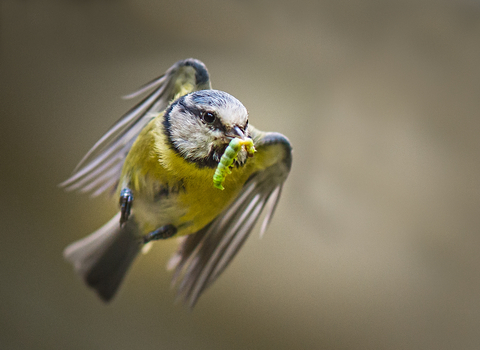
©Dave Kilbey

Gillian Lloyd

Bob Coyle
Blue tit
A familiar garden bird, the blue tit can be seen around bird tables and feeders, as well as in woodlands and parks. Listen out for its trilling, 'tsee-tsee-tsee' song. It is smaller than the great tit.
Scientific name
Cyanistes caeruleusWhen to see
January to DecemberSpecies information
Category
Statistics
Length: 12cmWingspan: 18cm
Weight: 11g
Average lifespan: 3 years
Common. Classified in the UK as Green under the Birds of Conservation Concern 5: the Red List for Birds (2021).
About
Smaller than the great tit, the blue tit is also a bird of woodland, parks and gardens. It nests in holes in trees, but is just as happy to use nestboxes. Blue tits are active feeders, hunting out insects and spiders among the smaller branches and leaves of trees in woodlands. But they are also well-adapted to gardens and towns and will visit birdtables and peanut feeders; they are even famed for breaking the tops of milk bottles and taking the creamy top off the milk. In winter, they will form flocks with other tits, roaming the countryside and visiting gardens in groups. Blue tits have a trilling, 'tsee-tsee-tsee' song.How to identify
The blue tit is a colourful little bird with a blue cap, white cheeks, black eyestripes, a greeny-blue back, yellow belly, and blue wings and tail.Distribution
Widespread.In our area
The latest results from the RSPB’s Big Garden Birdwatch have revealed the top three birds spotted in Shropshire were the house sparrow, blue tit and blackbird.
Did you know?
Like most birds, blue tits can see ultra-violet (UV) light. Studies have shown that the blue crown on their heads glows brightly under UV light. The brightness of the feathers is thought to provide a variety of signals; for instance, male blue tits have been shown to choose females with brightly coloured crowns as they make fitter mothers.Watch
Blue Tit (https://vimeo.com/444195109)
Blue Tit by Tom Hartwell
The latest results from the RSPB’s Big Garden Birdwatch have revealed the top three birds spotted in Shropshire were the house sparrow, blue tit and blackbird.

